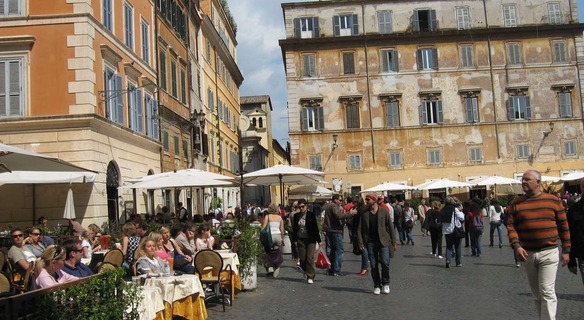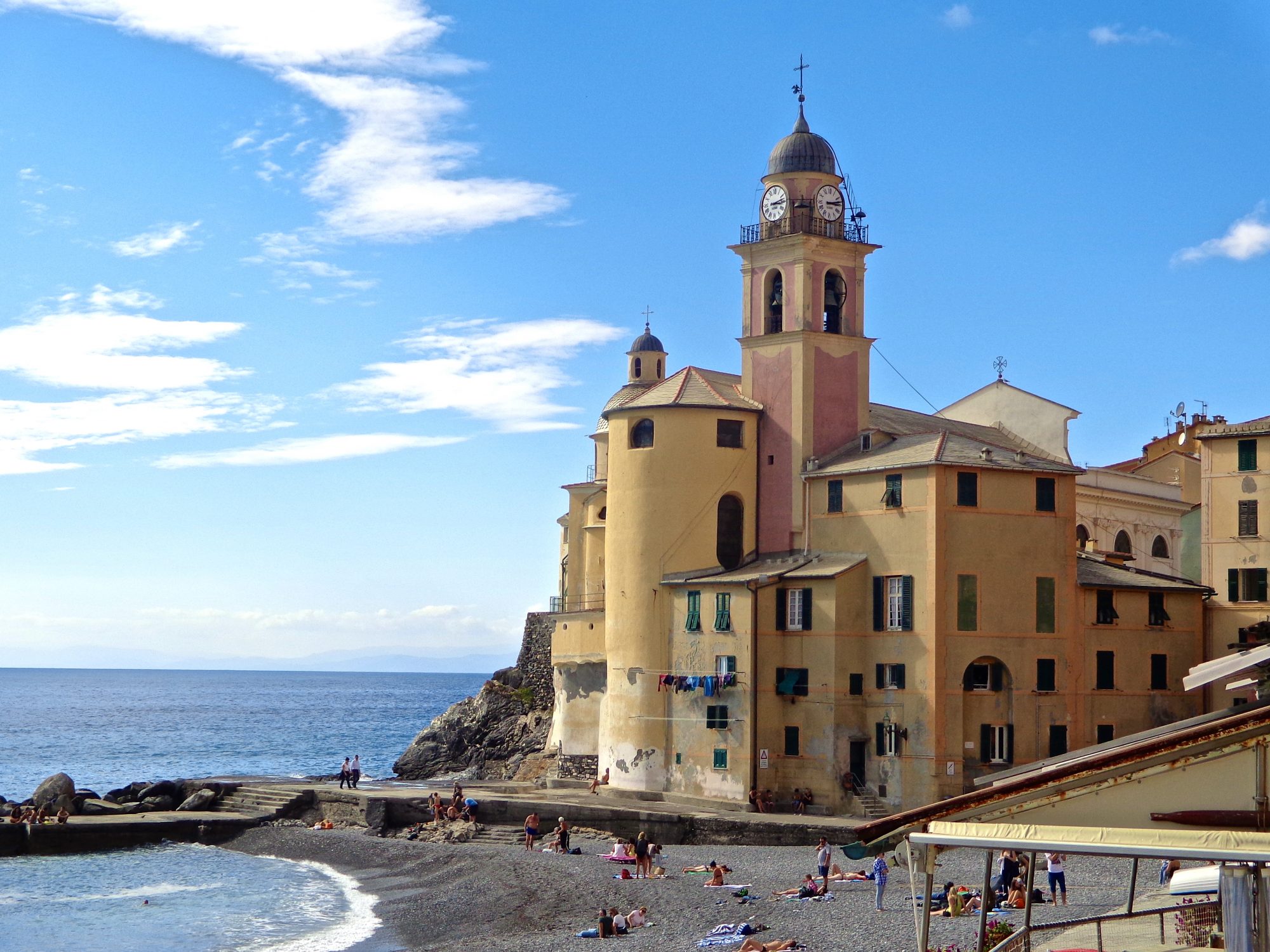
Jewish artichokes are a delicacy I was eager to try while in Rome. I’ve heard them described as delicate chrysanthemum-shaped with a crispy, salt-kissed taste. I knew I just had to try one given the opportunity. They are a big attraction in the restaurants of the old Jewish Ghetto. Also known as cardiofi alla giudia, artichokes were once a mainstay of the Roman Jews during times of scarcity and extreme hardship.
How could exquisite culinary delicacies evolve out of such extreme poverty and oppression?
Women of the Jewish Ghetto in Rome, established in 1555 by Pope Paul IV to sequester the Jews into one area, used what little they had to provide tasty meals for their families while also keeping them kosher. Artichokes, cheese, salt cod, and aubergines were cheap and used to create dishes that are considered gourmet cuisine today and served in fine dining restaurants throughout Rome.

The Jewish community began in Rome as early as 63 BC after the Romans invaded Judea and brought many of them back as slaves. Settling predominately on the east bank of the Tiber River, the walls (built in 1555) surrounding the ghetto kept them isolated for almost 300 years. The ghetto in Rome was one of the poorest in Italy. Desperately cramped, the Jews were forbidden to own property. They “were excluded from most professions except money-lending, dealing in old cloth and bric-a-brac, and selling food in the street. Many of them became friggitori-street vendors of deep-frying morsels, mainly of fish and vegetables for which they became famous,” describes Claudia Roden in her article “The Dishes of the Jews of Italy: A Historical Survey.”

The Roman Jewish Ghetto today is a maze of narrow winding streets, interesting shops, and several cute Kosher restaurants emitting delicious smells. Locals and tourists alike still flock to the old ghetto for carciofi alla guidia, Jewish style artichokes.
The Synagogue of Rome stands in the midst of the Jewish Ghetto where the original synagogue stood at one time. The ghetto is described as one of Rome’s most charming and eclectic neighborhoods, with restaurants serving up some of the best food in the city. The same little pieces of fried vegetables (artichokes, zucchini flowers, and salt cod), and fried fish chunks that are now served as fritto misto in the finest restaurants of Rome were sold centuries ago by the friggitori for only a few coins.
Ironically, today’s Jewish Ghetto property, which during the ghetto oppression was considered very undesirable, is now some of the most expensive in Rome.
Have you visited the Jewish Ghetto in Rome and tasted acarciofi alla guidia? What were your thoughts? I’d love to hear from you so please feel free to leave a comment.

Enjoyed your piece on my favourite vegetable, artichokes, and thought you might possibly like to read mine on the same subject at https://travels-with-my-camera.blog/2016/08/24/the-artichoke-romes-8th-king/
Your article has added a lot to the information I had on the artichoke in Rome’s culinary history, and thanks for that.
LikeLiked by 1 person
Hi Mari! Thank you…I just read your article and I loved it! Your photos are very nice, and I couldn’t help but chuckle to myself over your attempts at making artichokes the Roman way. I, too, would have had the same experience. There is something key that is lost in translation, I’m sure. If you go in May and get a kitchen experience on fried artichokes, let me know! Buon Natale
LikeLike
I lived in Rome in 1965 , as a matter of fact I lived at 51 via Margutta ( …utterlyunawares of the importance of that address until I saw ” the movie ” in 1976 in Encino of all places , on TV ..) .
There was a dish of artichokes I was particularly fond of , which I would find at the trattorias …then they seem to have disappeared , even in ” name” : carccioffini Romana !!
I travel to Rome fairly often and when I remember to ask I get these blank stares in return … what happened ?
Those were tiny artichokes , the French call them chardons and the Moroccans ” d’shoq” , they were breaded and deep fried ..one would eat the entire “fruit” .
Again : not carccioffi but carccioffiNI , indicating their small size .
LikeLiked by 1 person
I mistakenly refered to them as ” chardons”
LikeLiked by 1 person
Very interesting! I wish they were still available today…thanks for sharing.
LikeLike
Looking forward to my first Jewish Fried Artichoke!!!!
LikeLiked by 1 person
Great!!!
LikeLike
I didn’t love the one we tried. Maybe it was just not the best restaurant. I loved visiting the Jewish ghetto though. 😍.
LikeLiked by 1 person
Possibly…but it may be they are not for everyone’s taste. The Jewish ghetto is a favorite place of mine.
LikeLike
My mother would create different dishes with artichokes and no matter the variation, I couldn’t develop a taste for them!
LikeLiked by 1 person
Artichokes are one of those foods that you either love or don’t. I love them, so these were a special treat.
LikeLiked by 1 person
Kind of like grapes, just in reverse 🙂 , and how grapes are pretty much the fruit for the royalties. When I lived in Italy, my landlord used to invite me for dinner at their place. They offered me artichoke, but sorry to say, I couldn’t eat it. Not one of my proudest travel moments for sure.
LikeLike
Fascinating post, Susan. It really made me want to visit Rome’s Jewish ghetto. I’m thinking the next time we visit friends in Rome, I know where I want to go!! We’ve been to Venice’s Jewish ghetto, which was also very interesting. Yet also so sad that people would have been treated in such a way. And those artichokes look so good. Never tried them, but I’m willing to try (most) anything at least once! Rome, here we come – again!! 🙂
LikeLiked by 1 person
Thank you Sheila…it must be so nice to live in Italy with all these wonderful experiences at your fingertips:)
LikeLike
I love carciofi, but haven’t tried Carciofi alla Giudea. I seem to spend all my time in Roma eating suppli!
LikeLiked by 1 person
Suppli are easy to fill up on but they really are delicious!!
LikeLiked by 1 person
I haven’t tried a lot of Jewish foods, but I am currently living in a predominately Jewish area of Toronto, and am getting well educated by a close friend and fellow writer about the fascinating history and culture behind Judaism. I will have to start trying the food.
LikeLiked by 1 person
I’m not well versed on Jewish food either. But from what I’ve had I find it all very good. I hope you take advantage of your location among the Jewish people and give their cuisine a try:)
LikeLiked by 1 person
How interesting… it reminds me of lobster – in that it was fed to slaves and prisoners and used as bait and fertilizer because it was considered ‘poor man’s food’ when the first European settlers arrived here. And now, look how expensive it is.
I am not a fan of artichokes, but reading this, and the photos….. well, I may have to change that 🙂 Thanks for an interesting article Susan
LikeLiked by 1 person
I hope that you do give them a try. I love them! Very unusual, and if you like salty crispiness, you will be in heaven. The middle part is delicious too.
LikeLike
OMG this is my favorite! The leaves are like chips but the heart is done perfectly. This is a do not miss in Rome.
LikeLike
Carciofi alla giudea are soooo good!
LikeLike
Reblogged this on Italy: From St. Peter to Caravaggio.
LikeLike
this was an excellent piece. i loved reading it so much that i am going to put a link to it on my Italy post. please put a link back of it on your post so that it increases ranking and searchability of this post.
http://larkycanuck.com/2012/12/11/when-in-rome-do-as-i-do/
LikeLike
Thank you so much…it was fun researching it!
LikeLike
Inspiration for next week’s dinners, and interesting history to go along with it. Mille grazie. 🙂
LikeLike
Grazie Tricia! So glad you enjoyed the article. Artichokes are on the weekend menu in my house.
Buona salute,
Susan
LikeLike
Tricia, thank you for following….I am excited to have you on board!
Ciao
Susan
LikeLike
You lured me into reading with the artichokes—but a fascinating read, too!
Thanks~
Irene
http://www.moretimetotravel.com
LikeLike
Im so glad that you like it, Irene….keep thinking artichokes!! So delicious….
Susan
LikeLike